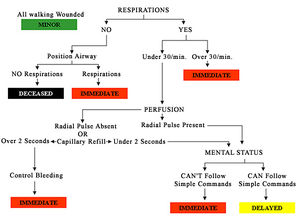We need you! Join our contributor community and become a WikEM editor through our open and transparent promotion process.
Mass casualty incident triage
From WikEM
Contents
Background
- Used by first responders to quickly classify victims during a mass casualty incident (MCI) based on the severity of their injury
Classification[1]
- Walking wounded/minor (green)
- Delayed (yellow)
- Immediate (red)
- Deceased/expectant (black)
Simple Triage and Rapid Treatment (START)
Always make sure you are safe. Then speak loudly and ask people to stand up and walk towards you. People who are:
- Able to walk relocate to a certain area (green)
- Non-ambulatory patients are then assessed
- No respirations → re-position airway
- No respirations (deceased/expectant)
- Respirations (immediate)
- Yes respirations
- >30/min (immediate)
- <30 → check perfusion
- Radial pulse absent OR capillary refill >2 seconds (immediate)
- Radial pulse present OR capillary refill <2 seconds → check mental status
- Unable to follow simple commands (immediate)
- Follows simple commands (delayed)
- No respirations → re-position airway
JumpSTART (Pediatric Patients)
- Able to walk relocate to a certain area (green)
- Non-ambulatory patients are then assessed
- No respirations → re-position airway
- Respirations (immediate)
- No respirations → check pulse
- No pulse (deceased/expectant)
- Yes pulse → 5 rescue breaths
- Still no respirations (deceased/expectant)
- Respirations (immediate)
- Yes respirations
- <15 or >45/min (immediate)
- 15-45/min → check perfusion
- Pulse absent or CRT >2 seconds
- Control bleeding (immediate)
- Pulse present or CRT <2 seconds → check mental status
- Inappropriate (immediate)
- Appropriate (delayed)
- Pulse absent or CRT >2 seconds
- No respirations → re-position airway
Secondary Assessment of Victim Endpoint (SAVE)
- Applies after patients have been triaged with START/jumpStart
- Designed for appropriation of limited resources for most gain in immediate on-scene care situations
- Three categories:
- Those who will die regardless of care
- Those who will survive whether or not they receive care
- Those who will benefit from limited immediate field interventions
See also
Video
References
- ↑ Lerner EB, Schwartz RB, Coule PL, et al. "Mass Casualty Triage: An Evaluation of the Data and Development of a Proposed National Guideline." Disaster Medicine and Public Health Preparedness 2(Suppl. 1) 2008, pp S25-S34.


